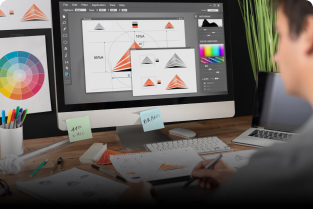In an era dominated by rapid technological advancements and ever-evolving creative trends, it’s natural to question the longevity of traditional professions. One such question often arises: Is graphic design a dead profession? The answer is a resounding no. However, the role of graphic design has undeniably evolved, adapting to new tools, technologies, and market demands.
The Changing Landscape of Graphic Design
Graphic design, at its core, is about visual communication. From creating logos and branding to designing websites and advertisements, the profession has always been essential to businesses and organizations. But with the rise of DIY design platforms, artificial intelligence (AI) tools, and templates, many wonder if the need for professional graphic designers is dwindling.
DIY Design Platforms
Platforms like Canva and Adobe Express have empowered individuals and small businesses to create designs without hiring professionals. These tools offer pre-designed templates and easy-to-use interfaces, making design accessible to non-designers. While these platforms are useful, they cannot replace the creativity, strategic thinking, and problem-solving skills of a trained graphic designer. Custom, high-quality designs that align with a brand’s identity still require professional expertise.
The Role of Artificial Intelligence
AI has undeniably made its mark on the design world. Tools like DALL-E, MidJourney, and Adobe Firefly can generate images and design elements in seconds. While AI can assist in streamlining workflows and generating ideas, it lacks the human touch necessary for understanding complex brand narratives, cultural nuances, and emotional connections. Designers who embrace AI as a tool rather than a threat can leverage it to enhance their creativity and productivity.
The Demand for Graphic Designers
Despite technological advancements, the demand for skilled graphic designers remains strong. According to industry reports, businesses continue to invest heavily in branding, marketing, and user experience (UX) design. The rise of digital marketing, e-commerce, and social media has further increased the need for compelling visual content.
Specializations Are Key
Graphic design is no longer limited to print media. Today, designers can specialize in various fields, such as:
- UI/UX Design: Crafting intuitive and visually appealing interfaces for websites and apps.
- Motion Graphics: Creating dynamic animations and videos for digital platforms.
- Branding: Developing cohesive brand identities that resonate with target audiences.
- Environmental Design: Designing physical spaces like retail stores, exhibitions, and events.
Freelancing and Remote Opportunities
The gig economy has opened new doors for graphic designers. Freelancing platforms like Upwork, Fiverr, and Behance allow designers to connect with clients worldwide. Remote work has also become a viable option, enabling designers to collaborate with global teams and access a broader range of opportunities.
Adapting to the Future
To stay relevant in this evolving industry, graphic designers must embrace lifelong learning and adaptability. Here are some tips for thriving in the profession:
- Learn New Tools: Stay updated on the latest design software and technologies, including AI tools.
- Expand Your Skill Set: Explore related fields like web development, digital marketing, or 3D design.
- Focus on Strategy: Offer more than just design; provide insights into branding and marketing strategies.
- Build a Strong Portfolio: Showcase a diverse range of projects to attract clients and employers.
- Network: Join design communities, attend events, and collaborate with other creatives to stay inspired and connected.
Conclusion
Graphic design is far from dead. It’s a profession that continues to evolve, driven by technological advancements and changing consumer needs. While tools like AI and DIY platforms have disrupted the industry, they cannot replace the creativity, strategy, and human touch that professional designers bring to the table. By adapting to new trends and continuously honing their skills, graphic designers can ensure their relevance and success in the ever-changing creative landscape.

